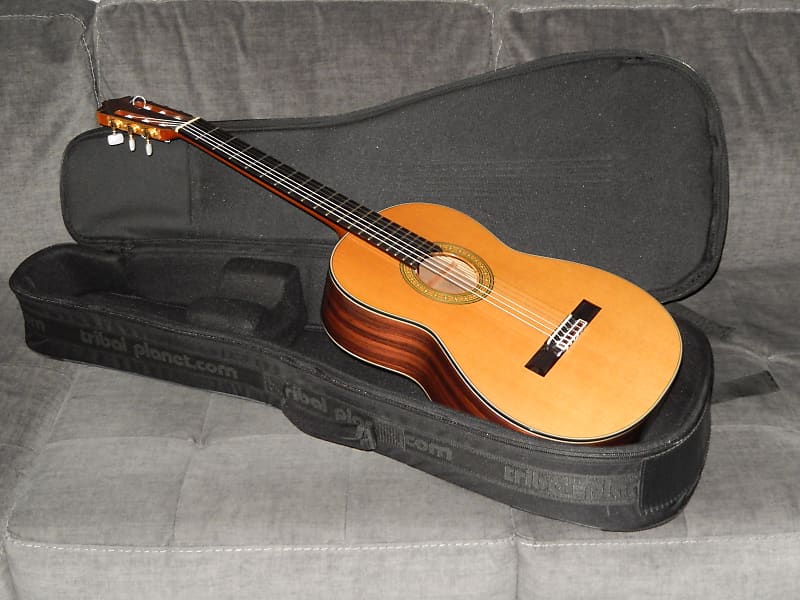

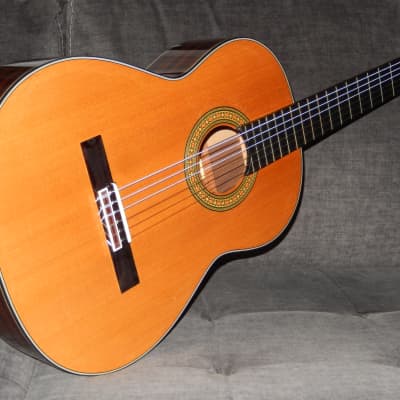
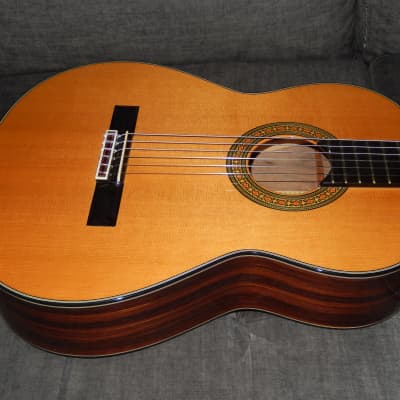
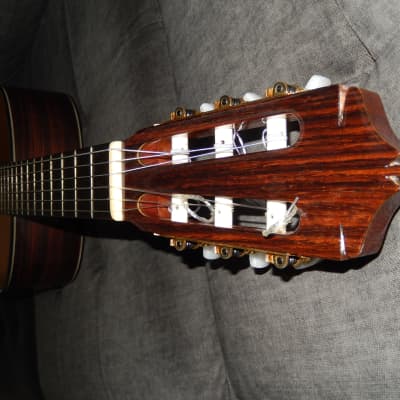
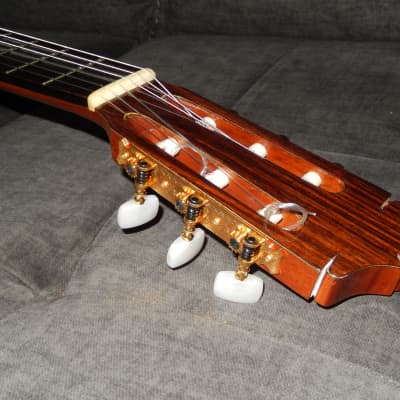
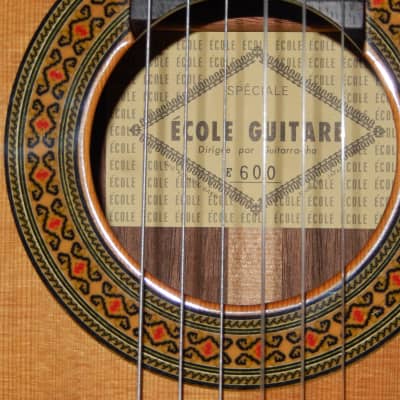
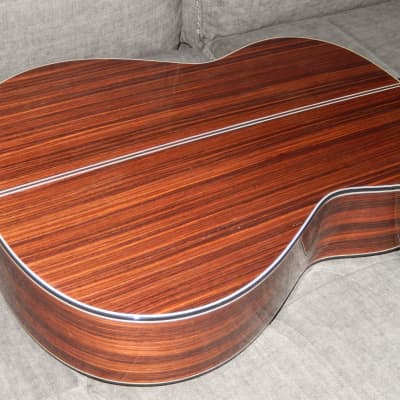
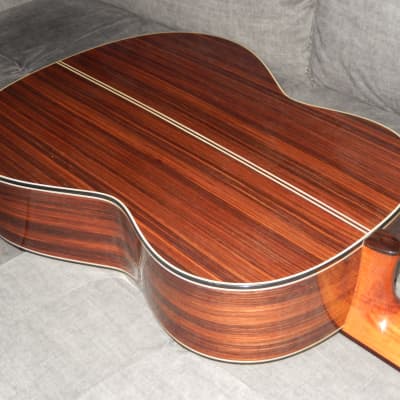
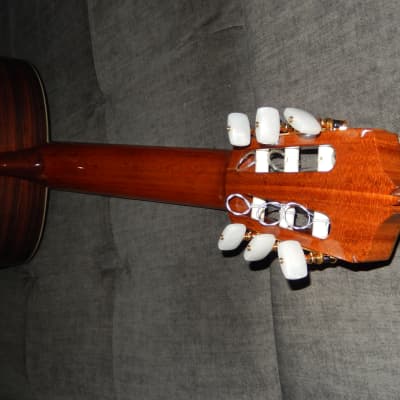
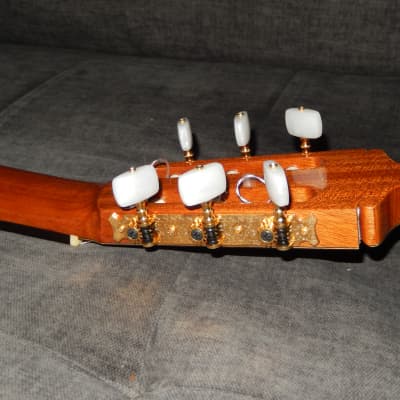
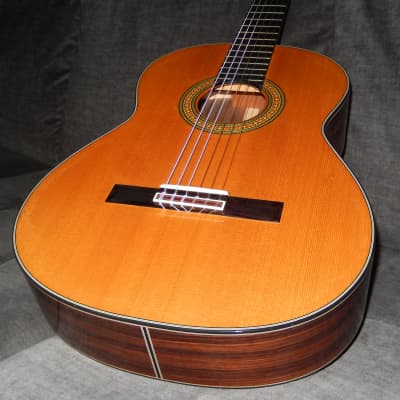
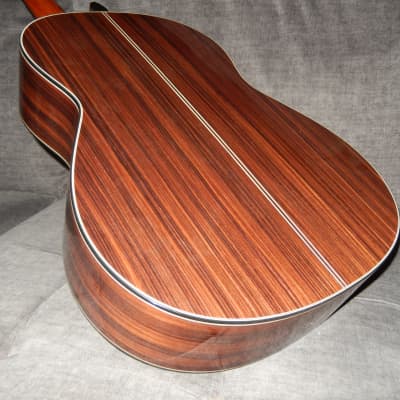
Ecole E600 Classical Guitar
This wonderful guitar was made in early/mid 2000s at Eichi Kodaira’s workshop. It certainly deserves its printed on the label title of “Special” Guitar. In terms of volume and tonality it exceeds many classical guitars currently sold on US market for $2500+.
It represents the same level as Takamine C132S (currently sold in USA for $1,949). Back in 2000s both guitars were priced at the same level.
To learn more about Eichi Kodaira you need to read “Asturias Story” presented below this posting.
This guitar remains in overall excellent condition. Besides bearing one very small dent on the soundboard, its body doesn’t show any other conspicuous cosmetic flaws.
Although I can't describe it as "concert" guitar it is certainly great instrument that will charm every listener. It offers quite impressive volume combined with very lyrical tonality, with somewhat metallic but full of overtones basses, colorful and super sweet glassy trebles, all with superb note clarity and separation, and exceptional sustain. With it's current action it is rather easy to play.
Specifications:
Top: Solid Cedar with Ramirez bracing and supporting ring of wood glued underneath sound-hole/lacquer
Back and Sides: Indian Rosewood double-plate/lacquer
“Laminated” is quite unfortunate term regarding Japanese made guitars. These "laminates" were made from 2 layers of solid wood glued together with natural resins. They were made so well that they performed as good as solid woods while being far less expensive in guitar production and far more resistant to cracking in regular use.
Neck: Mahogany
Fingerboard: Ebonized Rosewood
Scale: 650mm
Nut width: 52mm
String action is 3.50mm under E6 and 3.00 mm under E1 with plenty of extra room on the saddle.
This guitar will be shipped in used very sturdy semi-hard case.
“Asturias Story”
Asturias guitars have always had a great international reputation for tone and built quality. Asturias guitars are still made at the same small workshop located in Kurume, Japan. This workshop employs about 10 highly skilled craftsmen, each of them capable making a guitar on his/her own. Since 1981 Asturias workshop is led by master luthier Wataru Tsuiji
This workshop in Kurume began making guitars in 1962, under the name Meiko Gakki co. and ownership of Masaru Matano. Masaru Matano was Japanese luthier legend, until today remembered in Japan as “the genius of sound”. He earned this title before 1962, after improving the sound of many old violins, including famous Stradivarius violins.
Meiko Gakki workshop was making classical guitars in rather limited numbers, with emphasis placed on quality. Initially these guitars were sold under the Meiko Gakki label and just signed by Matano. Sometime in 1968 the labels were changed to Masaru Matano “Costructor de Guitarras” (and Meiko Gakki was placed below Matano’s name). Sometime in 1974 “Meiko Gakki” disappeared from the labels. During years 1974-1975 Masaru Matano introduced yet another series of guitars with their own unique design labels that had just Masaru Matano name on them and were marked as made in Fukuoka, Japan. This means that Kurume workshop wasn’t the only one Matano owned at that time. These Fukuoka made Matano guitars were made in rather limited quantities.
Well that is not all. Although some initial models of this series were made in late 1960s, during the same years 1974-1975 Masaru Matano with another group of associates was making wonderful La Esperanza guitars marked as made by Ongaku Geijutsusha Co. While most of Masaru Matano - Meiko gakki guitars had Cedar tops and Matano’s unique design headstocks, La Esperanza guitars had mostly Spruce tops and Ramirez style headstocks. La Esperanza guitars had exactly the same style labels as those used on Matano – Meiko Gakki guitars. While great majority of Matano’s own label guitars were not signed by him or anybody else, many La Esperanza guitars had labels signed by their actual makers. Esperanzas made by Matano himself have his signature their labels. It is quite likely that La Esperanza guitars were also made at Matano’s Fukuoka workshop. La Esperanza guitars were made until 1982, but never in large quantities.
It is not a secret that (just like most other luthiers in the world) Matano always had a team of highly skilled associates. One of them was Tatsuo Tanaka. In late 1960s, Tatsuo was the only Matano’s associate, who could put his name on Meiko Gakki label. Tatsuo Tanaka could have been Matano’s partner at that time, but this is not confirmed by any published records. Also, there are no written records revealing the names of other Matano’s associates. It is very possible that Hiroumi Yamaguchi and Eichi Kodaira were among these associates. Both these luthiers started their own workshops in early 1970s and prospered well on their own, but joined “New” Asturias team in 1980. In 1980 Matano’s Kurume workshop was taken over by Rokkomann Co (Japanese leading lumber importer) and “New” Asturias workshop came into life. The details of this transaction are totally unclear and Matano’s disappearance in 1981 never explained to the public. Since 1981 Asturias workshop is led by Wataru Tsuji, a younger luthier who started to work for Masaru Matano in 1977.
In 1981 “New” Asturias workshop started to use serial number system on their labels. The design of Asturias labels (unchanged until today) was created sometime in mid1970s and used on some Masaru Matano’s guitars, while other guitars still had “Masaru Matano - Meiko Gakki” labels. Some of these earlier Asturias labels were printed as “Asturias by Masaru Matano”. Very few of these early (before 1980) Asturias guitars were ever signed by Masaru Matano.
Hiromi Yamaguchi’s name for the first time appeared on guitar labels in early 1970s. Yamaguchi established his own brand: “Cervantes” Concierto Guitarras. His Cervantes guitars, not only looked like Masaru Matano -Meiko Gakki ones, but were made exactly the same way, and sounded as great as Matano’s creations. The only difference were headstock designs. After Yamaguchi joined “New” Asturias team in 1980, he (or just his workshop) was still making Cervantes guitars. Cervantes guitars were made until 1982. In the same year 1982 Hiroumi left Asturias team and started building guitars under his own name. Hiroumi retired sometime in early 1990s. Eichi Kodaira, since early 1970s was making 2 lines of guitars, one with his own name on the labels and second labelled as Ecole Guitarras. Ecole guitars had more ornamental extras and were considered as more luxurious brand. Within “New” Asturias team, Eichi Kodaira was responsible for making all AST models. Sometime in 1983-1984 Eichi and a group of his closest associates moved to another workshop located in Suwa (Nagano Prefecture) and started making Asturias Kodaira guitars, identical with AST models earlier made at Kurume workshop. Yet few years later, Eichi stopped making Asturias/Kodaira guitars and continued making AST models just as Kodaira guitars. His workshop operates until today with only 3 employees: Eichi’s son and 2 other Kodaira family members.
All guitars made by these Asturias associated luthiers are very high grade, well regarded by a lot of international players who consider them as the best mid-price range classical concert guitars. It is also very important to tell you, that guitars made by these makers have always been very moderately priced if compared to similar grade guitars made by Masaru Kohno or other Japanese Elite luthiers. Until 1980 Masaru Matano’s top model was Classe 1000 (priced 100 000 yen). This model was the only “all solid woods” one in Matano’s lineup. This guitar however could easily compete with Masaru Kohno #20 from the same year. Until 1982 top Cervantes, La Esperanza and Ecole models were also priced 100 000 yen.
Important message for Australian buyers:
USPS International Priority Mail packages destined for Australia have quite restricted size (max. length is 42” and max. length + girth is 97”). For these reasons I must use the case that is no longer than 41” and therefore it may be different than the one you see on the pictures. You should ask me for any other details prior to making a purchase.
Reverb Buyer Protection
Reverb has your back if your item is lost, damaged, or doesn't match its description. Simply report any issues within 7 days and we'll help you get a full refund.Learn more about Reverb Buyer Protection.
| Listed | 5 years ago |
| Condition | Excellent (Used) Excellent items are almost entirely free from blemishes and other visual defects and have been played or used with the utmost care.Learn more |
| Brand | |
| Model |
|
| Finish |
|
| Categories | |
| Year |
|
| Made In |
|
| Body Shape |
|
